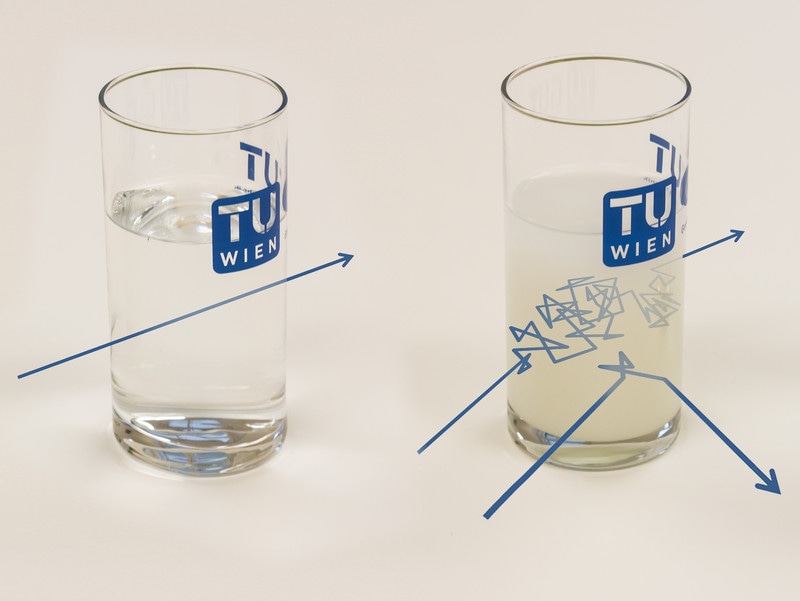Nov 13 2017
Imagine the outcome of light passing through a glass containing milk. When the light enters the milk, it is scattered in an erratic manner by innumerable tiny particles and then leaves the glass. The effect gives milk its white color.
 Light on its way through a liquid: In case of a transparent liquid (left) light paths are straight lines. In case the liquid is made opaque through nanoparticles (right) light paths get more complicated through scattering. Some of the paths become longer, others shorter—on average though the length of light paths is the same as in the transparent case. Credit: TU Wien
Light on its way through a liquid: In case of a transparent liquid (left) light paths are straight lines. In case the liquid is made opaque through nanoparticles (right) light paths get more complicated through scattering. Some of the paths become longer, others shorter—on average though the length of light paths is the same as in the transparent case. Credit: TU Wien
However, the particular paths taken by the incident beam of light are dependent on the liquid’s opacity. That is, a transparent substance allows a straight line passage of light through it. In the case of a turbid substance, the light is scattered innumerable times and travels on highly complicated zig-zag paths. However, quite fascinatingly, the average total distance that light covers inside the substance is always the same.
Three years earlier, professor Stefan Rotter and his colleagues, from TU Wien, Austria, speculated this counter-intuitive outcome by collaborating with their French collaborators. At present, Rotter and his colleagues from Paris validated this theory by performing an experiment. The outcomes of the study have been published in the “Science” journal.
Particles and Waves
“We can get a simplified idea of this phenomenon when we imagine light as a stream of tiny particles,” stated Stefan Rotter. “The trajectories of the photons in the liquid depend on the number of obstacles they encounter.”
In the case of an entirely transparent, clear liquid, the particles move along straight lines before leaving the liquid from the other side. In contrast, in an opaque liquid, the paths of light are more complicated. The light beam is scattered often along its path, its direction is changed a number of times, and it can leave from the other side after traveling a long distance inside the opaque liquid.
However, in the case of a turbid liquid, many photons are prevented from reaching the other side. Instead of completely passing through the liquid, the photons penetrate a little below the surface and they leave the liquid again aftern less scattering occurs, hence their paths are cut short. “It can be shown mathematically that, rather surprisingly, these two effects exactly balance,” stated Stefan Rotter. “The average path length inside the liquid is thus always the same—independent of whether the liquid is transparent or opaque.”
We have to take into account that light travels through the liquid as a wave rather than as a particle along a specific trajectory, this makes it more challenging to come up with a mathematical description, but as it turns out, this does not change the main result. Also if we consider the wave properties of light the mean length associated with light penetrating the liquid always stays the same, irrespective of how strongly the wave is scattered inside the medium.
Professor Stefan Rotter, TU Wien
Experiments in troubled water
The theoretical computations revealing this counterintuitive behavior were published 3 years earlier in a collaborative publication by Stefan Rotter and his colleagues, as well as his colleagues from Paris. Currently, the same teams have managed to validate the astonishing outcome in an experiment. Water was filled in test tubes and was then mystified with nanoparticles. When more nanoparticles were added, the scattering of light was more strong and the liquid looked further turbid.
“When light is sent through the liquid, the way it is scattered changes continuously, because the nanoparticles keep moving in the liquid,” stated Stefan Rotter. “This leads to a characteristic sparkling effect on the tubes’ outer surface. When this effect is measured and analysed carefully, it can be used to deduce the pathlength of the light wave inside the liquid.” Moreover, in fact, regardless of the number of nanoparticles, the average path length of light did not vary with respect to whether the light was passed through a milk-like liquid or a nearly transparent sample, and was noted to be the same always.
This outcome assists in gaining an in-depth knowledge of the traveling of waves through disordered media. There are numerous prospective applications for this: “It is a universal law, which in principle holds for any kind of wave,” stated Stefan Rotter. “The same rules that apply to light in an opaque liquid also hold for sound waves, scattered at tiny objects in air or even gravity waves, travelling through a galaxy. The basic physics is always the same.”